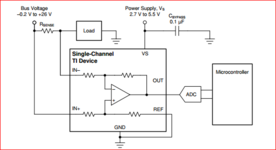adnan012
Advanced Member level 1

Hi
I am looking for a DC current sense circuit which can measure 10-30A current with 0.5A accuracy. The shunt is 1mR. Which configuration of op-amp is suitable for this application? I want to use LM358.
Best regards
I am looking for a DC current sense circuit which can measure 10-30A current with 0.5A accuracy. The shunt is 1mR. Which configuration of op-amp is suitable for this application? I want to use LM358.
Best regards




